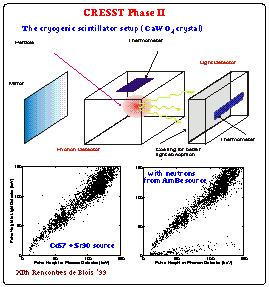


Although research in the field of direct detection evolves rapidly and more exciting results can be expected for the near future as mentioned above, there are three proposed detection concepts which shall be reported separately in order to point out their exceptional prospects (2)
The DRIFT experiment (see Fig. 6) [43] represents the only test-phase operating recoil-direction sensitive experiment. It consists of a low-pressure TPC using 20 torr Xe-CS2 (50:50) gas mixture. The crucial point for such a device is that it must be able to detect reliably the tiny tracks from nuclear recoils, i.e. the design goal is to achieve a less than 1 mm track resolution. In order to setup higher target masses despite the low-pressure gas, the idea is to abandon the magnetic field. That would in principle worsen the track resolution due to enhanced diffusion. Therefore the detection concept has been changed in the sense that the TPC does not detect the drifted electrons but rather negative CS2- ions with considerably reduced diffusion. The prospects for this setup are very encouraging due to the ability to measure the most decisive WIMP-signature, the diurnal modulation due to the WIMP-wind. The plan is to operate a 20 m3 TPC by the end of 2001.

|
Figure 6. Summary of the DRIFT experiment and schematic view of their TPC setup [43] (for details, see text). |
The GENIUS proposal [24] is exceptional in the sense that it is a detection concept which works without specialised background discrimination procedures, i.e. it will not use nuclear recoil specific observables. This traditional detection method, using germanium semiconductor detectors, relies therefore on the utilisation of extreme radio-pure materials around the detectors. The idea is to remove all materials close to the crystals which were so far necessary to cool the detectors and instead operate them directly in liquid nitrogen which has been measured to be a very pure environment. The necessity to use that liquid nitrogen as shielding material scales the setup to a rather large size (dewar of 12 m diameter and height). On the other hand, that also admits to operate a large target mass (100 kg of natural germanium is planned for the first stage) in a common environment. The technical studies of operating 'naked' germanium crystals in liquid nitrogen have already been performed successfully. An estimation of the expected sensitivity, i.e. the background expected, can be seen in Fig. 7. Most dangerous appears the cosmic activation of the crystals while produced and transported on the earth surface due to spallation reactions with cosmic rays (hadronic component). The cited background expectation of 3.1 10-2 counts/(y kg keV) below 100 keV would result in a WIMP-sensitivity more than 3 orders of magnitude below current best limits which definitely is an encouraging prospect.

|
Figure 7. Shown are the background expectations for GENIUS according to Monte-Carlo simulations [24]. Contributions from liquid nitrogen, the holder system, external background and cosmic activation have been included. Also shown is the sumspectrum and the contribution from the two-neutrino double beta decay of 76Ge in the natural germanium crystals. |
The CRESST phase II concept [12, 44] consists of a combined signal readout from a scintillating crystal cooled to 12 mK. The light and phonon readout yields a very efficient discrimination mechanism as can be see in Fig. 8. Test measurements using a non-optimised setup in a surface laboratory already give background suppression factors comparable to the ionization-phonon readout schemes seemingly without the problem of surface effects. Several scintillating crystals have been tested (BaF2, BGO, PbWO4 and CaWO4) and their light yields at cryogenic temperatures measured. The operation of the scintillator as a cryogenic calorimeter poses special problems for the light detection since no light guide touching the crystal surface (matching refractive indices) is allowed since that would distort the phonon signal. For light detection a second calorimeter, a thin sapphire crystal coated with silicon to improve light absorption, is placed next to one surface of the scintillator and the other surfaces are surrounded by mirrors (compare Fig. 8) (3) . Apart from the discrimination abilities of the detector concept there is an additional advantage. Several target materials or scintillators can be used in such kind of setup which would result in an unique handle not only on the discrimination of the ambient neutron background, so far considered to be the ultimate limiting factor, but also on the extraction of the WIMP signal due to its target mass dependence (see eq. 1). Moreover, already in the existing cryogenic setup inside the Gran Sasso underground laboratory there is enough space to house some tens of kilogramms of active mass, rendering a modulation signature search possible. A first scintillation detector made from CaWO4 is expected to be mounted underground already at the beginning of 2000.

|
Figure 8. CRESST phase II setup and test measurement results [12] (for details, see text). |
2 Admittedly, due to personal preferences.
Back.
3 New
measurements use diffuse Teflon reflectors instead, resulting in a factor two
per unit area more efficient light yield
[44].
Back.